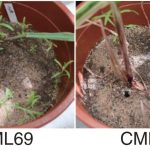Plant Science Research Weekly: January 27, 2023
Running a research group in the next generation: Combining sustainable and reproducible research with values-driven leadership
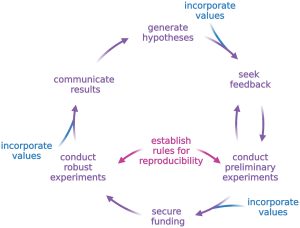 This is a fantastic article to help new, future, and even current lab heads think about their postures, priorities, and practices. It was developed through a workshop held during the Arabidopsis meeting, originally scheduled for 2020 but held online in 2021 and run by several scientists who recently became principal investigators. The first part provides excellent recommendations for developing that all-important fundable research program. The next addresses lab culture and provides tips for how to identify and prioritize what you and your lab group value. Finally, suggestions for how to ensure that your lab’s output is reproducible are provided, starting with the statistic that “70% of surveyed researchers report having trouble replicating either their own findings or those of their peers.” Instilling good data management practices in trainees is perhaps one of the most critical lessons a PI can provide, both for the future success of their protégés and the long-term soundness of science. Transparency in communications and sharing of resources and protocols are also critical habits to impart. (Summary by Mary Williams @PlantTeaching) J. Exp. Bot. 10.1093/jxb/erac407
This is a fantastic article to help new, future, and even current lab heads think about their postures, priorities, and practices. It was developed through a workshop held during the Arabidopsis meeting, originally scheduled for 2020 but held online in 2021 and run by several scientists who recently became principal investigators. The first part provides excellent recommendations for developing that all-important fundable research program. The next addresses lab culture and provides tips for how to identify and prioritize what you and your lab group value. Finally, suggestions for how to ensure that your lab’s output is reproducible are provided, starting with the statistic that “70% of surveyed researchers report having trouble replicating either their own findings or those of their peers.” Instilling good data management practices in trainees is perhaps one of the most critical lessons a PI can provide, both for the future success of their protégés and the long-term soundness of science. Transparency in communications and sharing of resources and protocols are also critical habits to impart. (Summary by Mary Williams @PlantTeaching) J. Exp. Bot. 10.1093/jxb/erac407
Special issue: Rubisco and its regulation – major advances to improve carbon assimilation and productivity
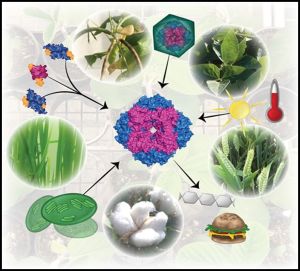 Rubisco (ribulose-1,5-bisphosphate carboxylase) catalyzes the fixation of atmospheric carbon from CO2 to molecules used for biosynthesis and energy production. Several studies have focused on understanding the nature, complexity, activity, and regulation of Rubisco due to its key role in the production of carbohydrates. A new special issue of the Journal of Experimental Botany highlights advances in Rubisco research. For example, Bracher et al. show that the Rubisco folding pathway within higher plant chloroplasts requires chaperonin 60/20/10 complexes and specific auxiliary factors (such as Raf1, Rad2, BSDII, and RbcX). Qu et al. show that isoforms of Rubisco activase are active in warmer temperatures. Ang et al. detail how Rubisco condensation within pyrenoids and carboxysomes by liquid-liquid phase separation has helped in understanding Rubisco aggregation by disordered linkers such as EPYC1, and the possible transfer of these solutions from nature into improved crops. As revealed in this special issue, studies of Rubisco have provided a platform that facilitates understanding of protein folding, assembly, and intricacies of regulatory mechanisms underlying the dynamics of plant metabolic responses to changes in the environment. (Summary by Abdulmalik, Abdulkabir Omeiza @Omeiza_PlantDoc) Issue link https://academic.oup.com/jxb/issue/74/2
Rubisco (ribulose-1,5-bisphosphate carboxylase) catalyzes the fixation of atmospheric carbon from CO2 to molecules used for biosynthesis and energy production. Several studies have focused on understanding the nature, complexity, activity, and regulation of Rubisco due to its key role in the production of carbohydrates. A new special issue of the Journal of Experimental Botany highlights advances in Rubisco research. For example, Bracher et al. show that the Rubisco folding pathway within higher plant chloroplasts requires chaperonin 60/20/10 complexes and specific auxiliary factors (such as Raf1, Rad2, BSDII, and RbcX). Qu et al. show that isoforms of Rubisco activase are active in warmer temperatures. Ang et al. detail how Rubisco condensation within pyrenoids and carboxysomes by liquid-liquid phase separation has helped in understanding Rubisco aggregation by disordered linkers such as EPYC1, and the possible transfer of these solutions from nature into improved crops. As revealed in this special issue, studies of Rubisco have provided a platform that facilitates understanding of protein folding, assembly, and intricacies of regulatory mechanisms underlying the dynamics of plant metabolic responses to changes in the environment. (Summary by Abdulmalik, Abdulkabir Omeiza @Omeiza_PlantDoc) Issue link https://academic.oup.com/jxb/issue/74/2
Genome editing around the globe: An update on policies and perceptions
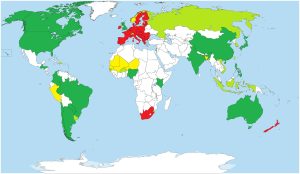 The CRISPR/Cas system has become a popular genome editing (GEd) method in animals and plants, which allows very fine alterations in target genes and avoids the concerns that accompany introducing genes from other organisms. To improve food security and accelerate breeding. this technology has been applied to important crops such as rice, sorghum, maize, and tomato, However, regulations about GEd in plants is subject to debate in different countries. Sprink et al. examine the application of GEd in plants and give an update on police and perceptions in several countries. They mention that the debate on GEd technology is largely focused on whether the resulting plants should be considered genetically modified organisms (GMOs); this designation causes problems in many countries due to the lack of regulatory approval. Furthermore, the authors discuss the perception of GEd in society and how these emerging technologies offer the opportunity to address social and climate challenges. The article shows that scientists, society, and policymakers must work together to achieve the regulation of new genome editing technologies. (Summary by Andrea Gómez-Felipe @andreagomezfe) Plant Physiol. 10.1093/plphys/kiac359
The CRISPR/Cas system has become a popular genome editing (GEd) method in animals and plants, which allows very fine alterations in target genes and avoids the concerns that accompany introducing genes from other organisms. To improve food security and accelerate breeding. this technology has been applied to important crops such as rice, sorghum, maize, and tomato, However, regulations about GEd in plants is subject to debate in different countries. Sprink et al. examine the application of GEd in plants and give an update on police and perceptions in several countries. They mention that the debate on GEd technology is largely focused on whether the resulting plants should be considered genetically modified organisms (GMOs); this designation causes problems in many countries due to the lack of regulatory approval. Furthermore, the authors discuss the perception of GEd in society and how these emerging technologies offer the opportunity to address social and climate challenges. The article shows that scientists, society, and policymakers must work together to achieve the regulation of new genome editing technologies. (Summary by Andrea Gómez-Felipe @andreagomezfe) Plant Physiol. 10.1093/plphys/kiac359
Review: Not only turgor can shape plant growth!
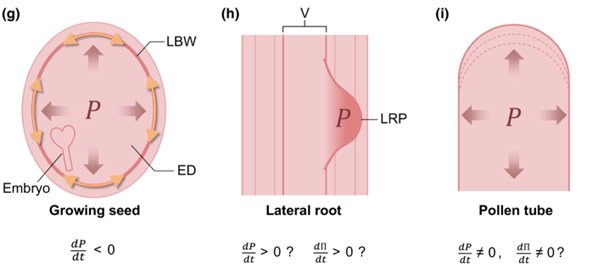 Cell wall tensile stress and turgor pressure are two important determinants of cell growth. Turgor pressure has been regarded as a passive contributor, however recent evidence reviewed by Ali et al. suggests that turgor is an emergent property that determines growth. Wall stress and turgor pressure are inter-reliant and a defect in one component can impact the other. Furthermore, the size and shape of cells can affect turgor, wall stress, and growth. Non-spherical shapes such as leaf puzzle-shaped cells can decrease wall stress, while smaller cells have less turgor. The authors explore the relationship between turgor and wall strength in several tissues. In seeds, the pressure exerted by endosperm triggers growth during initial stages, while towards the end of the grain filling period growth is arrested by cell wall thickening of the seed coat. The emergence of lateral roots penetrating different cell layers is facilitated by auxin dependent repression of aquaporins, resulting in a rapid buildup of turgor. In pollen tubes, growth is turgor dependent, even though growth rate and oscillatory growth are not entirely turgor dependent. The multipronged role of compatible solutes in plant metabolism and structural integrity enables the integration of metabolic, mechanical and hydraulic signals by turgor. Translating uniform turgor/wall pressure into growth signals requires directionality cues and signaling intermediates including receptor kinases and mechanosensitive channels. (Summary by Lekshmy Sathee @lekshmysnair) New Phytol. 10.1111/nph.18683
Cell wall tensile stress and turgor pressure are two important determinants of cell growth. Turgor pressure has been regarded as a passive contributor, however recent evidence reviewed by Ali et al. suggests that turgor is an emergent property that determines growth. Wall stress and turgor pressure are inter-reliant and a defect in one component can impact the other. Furthermore, the size and shape of cells can affect turgor, wall stress, and growth. Non-spherical shapes such as leaf puzzle-shaped cells can decrease wall stress, while smaller cells have less turgor. The authors explore the relationship between turgor and wall strength in several tissues. In seeds, the pressure exerted by endosperm triggers growth during initial stages, while towards the end of the grain filling period growth is arrested by cell wall thickening of the seed coat. The emergence of lateral roots penetrating different cell layers is facilitated by auxin dependent repression of aquaporins, resulting in a rapid buildup of turgor. In pollen tubes, growth is turgor dependent, even though growth rate and oscillatory growth are not entirely turgor dependent. The multipronged role of compatible solutes in plant metabolism and structural integrity enables the integration of metabolic, mechanical and hydraulic signals by turgor. Translating uniform turgor/wall pressure into growth signals requires directionality cues and signaling intermediates including receptor kinases and mechanosensitive channels. (Summary by Lekshmy Sathee @lekshmysnair) New Phytol. 10.1111/nph.18683
A paternal perspective on maternal inheritance
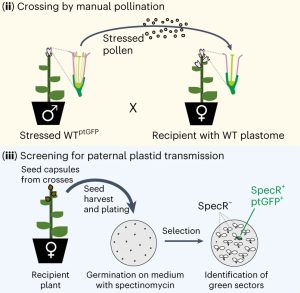 Nuclear DNA is inherited from both parents during sexual reproduction, but organellar DNA is (usually) exclusively received from the mother. However, stable biparental inheritance of organellar DNA has also been reported in plants and animals but its molecular mechanism is unknown. Using quantitative genetic screening, Chung et al. hypothesized that altered plastid inheritance patterns can result from stress-induced pollen development. They used a pollen donor carrying spectinomycin resistant fluorescently-labeled plastids to fertilize a pollen receiver with spectinomycin sensitive plastids. Spectinomycin suppresses greening by preventing the production of plastid proteins. Upon spectinomycin exposure, tissues exclusively carrying maternal plastids turned white while green sectors revealed the presence of paternal plastids. Paternal plastid transfer is extremely rare under normal circumstances, but mild chilling stress (at 10°C) increased the probability of paternal transmission by 150 times. Furthermore, the authors demonstrated that the exonuclease DPD1 (Defective in Pollen organelle DNA Degradation 1) is involved in plastid inheritance by showing that the tobacco dpd1 knockout mutant, which retains organellar DNA during pollen production, has a 120-fold higher paternal plastid transmission rate. As the paternally inherited plastids can be passed on to the progeny, they can potentially influence plant evolution and facilitate plant breeding. (Summary by Rajarshi Sanyal @rajarshi_sanyal) Nature Plants 10.1038/s41477-022-01323-7
Nuclear DNA is inherited from both parents during sexual reproduction, but organellar DNA is (usually) exclusively received from the mother. However, stable biparental inheritance of organellar DNA has also been reported in plants and animals but its molecular mechanism is unknown. Using quantitative genetic screening, Chung et al. hypothesized that altered plastid inheritance patterns can result from stress-induced pollen development. They used a pollen donor carrying spectinomycin resistant fluorescently-labeled plastids to fertilize a pollen receiver with spectinomycin sensitive plastids. Spectinomycin suppresses greening by preventing the production of plastid proteins. Upon spectinomycin exposure, tissues exclusively carrying maternal plastids turned white while green sectors revealed the presence of paternal plastids. Paternal plastid transfer is extremely rare under normal circumstances, but mild chilling stress (at 10°C) increased the probability of paternal transmission by 150 times. Furthermore, the authors demonstrated that the exonuclease DPD1 (Defective in Pollen organelle DNA Degradation 1) is involved in plastid inheritance by showing that the tobacco dpd1 knockout mutant, which retains organellar DNA during pollen production, has a 120-fold higher paternal plastid transmission rate. As the paternally inherited plastids can be passed on to the progeny, they can potentially influence plant evolution and facilitate plant breeding. (Summary by Rajarshi Sanyal @rajarshi_sanyal) Nature Plants 10.1038/s41477-022-01323-7
Identification of the rice Rc gene as a main regulator of seed survival under dry storage conditions
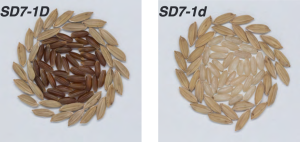 One of the current challenges in seed conservation is identifying the genetic basis that defines how long seeds can be stored before losing viability. This challenge is exceptionally crucial for rice, a cereal that feeds roughly half of the world’s population. However, most studies looking for determinant genes for seed longevity use warm and moist conditions unlike the dry, cool environment used for storage. Here, Prasad and colleagues look for potential genes associated with seed longevity by evaluating the variability in seed longevity of 20 rice accessions under elevated partial pressure of oxygen (EPPO). These experimental settings allow seeds to be tested under the temperature and humidity conditions that seeds encounter during storage while increasing the availability of oxygen, one of the molecules responsible for the aging process. The variation in the germination after the EPPO treatment was significantly explained by allelic differences in the gene Rc, which encodes a transcription factor involved in the synthesis of pro-anthocyanidin in the rice pericarp. Functional validation of this gene revealed that seeds from plants with a defective copy showed decreased longevity. As a result, this study provides exciting insights that might guide future breeding efforts toward longer-lived rice seeds. (Summary by Carlos A. Ordóñez-Parra @caordonezparra) bioRxiv 10.1101/2022.12.08.519629
One of the current challenges in seed conservation is identifying the genetic basis that defines how long seeds can be stored before losing viability. This challenge is exceptionally crucial for rice, a cereal that feeds roughly half of the world’s population. However, most studies looking for determinant genes for seed longevity use warm and moist conditions unlike the dry, cool environment used for storage. Here, Prasad and colleagues look for potential genes associated with seed longevity by evaluating the variability in seed longevity of 20 rice accessions under elevated partial pressure of oxygen (EPPO). These experimental settings allow seeds to be tested under the temperature and humidity conditions that seeds encounter during storage while increasing the availability of oxygen, one of the molecules responsible for the aging process. The variation in the germination after the EPPO treatment was significantly explained by allelic differences in the gene Rc, which encodes a transcription factor involved in the synthesis of pro-anthocyanidin in the rice pericarp. Functional validation of this gene revealed that seeds from plants with a defective copy showed decreased longevity. As a result, this study provides exciting insights that might guide future breeding efforts toward longer-lived rice seeds. (Summary by Carlos A. Ordóñez-Parra @caordonezparra) bioRxiv 10.1101/2022.12.08.519629
Selecting the best candidates for resurrecting extinct-in-the-wild plants from herbaria
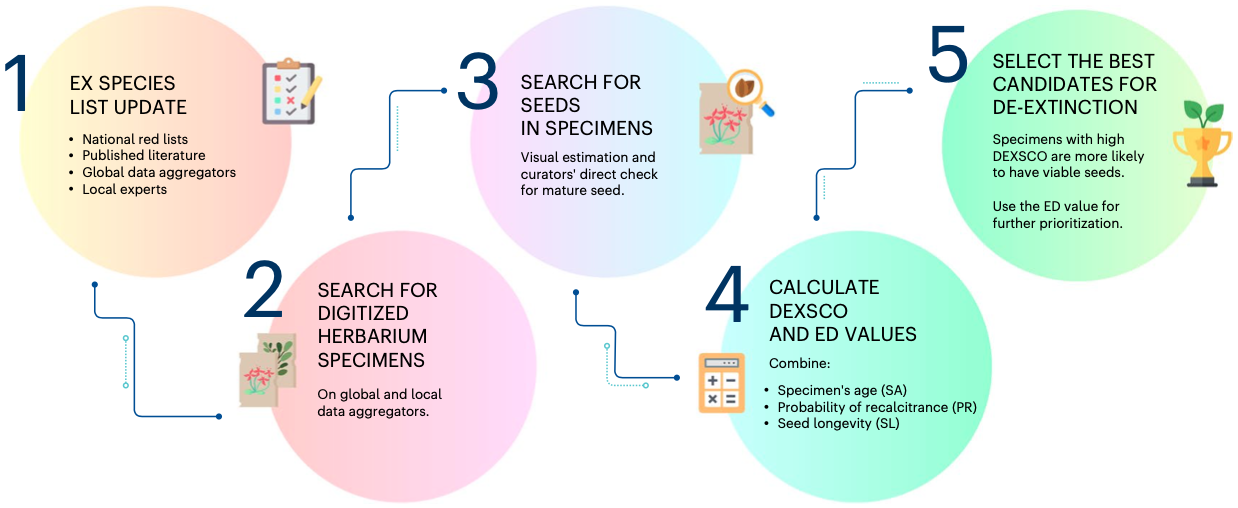 Many plants have gone extinct in their natural habitat, but persist as samples preserved in herbaria around the globe. The existance of these samples raises questions about the possibility of using them to “bring back to life” these species, for example, by germinating the seeds or spores available in the herbarium material. However, there is no agreement about the availability of this approach or practical guidelines for implementing it. Albani Rocchetti and colleagues contribute to these efforts by providing a methodology for prioritizing taxa in which this technique has a higher chance of success. The authors create the DEXSCO (de-extinction score) index, which combines information on collection year, seed longevity, and desiccation tolerance. After estimating the index for 361 globally extinct species, the authors identified the top 50 species with the highest probability of being recovered. Notably, most of these species are from the Fabaceae, Malvaceae, Asteraceae, Amaranthaceae and Campanulace families, demonstrating the potential of this technique for these clades. It should be noted, however, that protocols for germinating plant material extracted from herbaria are still required. Even so, this research provides a hopeful starting point for recovering some of the species that humanity has lost. (Summary by Carlos A. Ordóñez-Parra @caordonezparra) Nature Plants 10.1038/s41477-022-01296-7
Many plants have gone extinct in their natural habitat, but persist as samples preserved in herbaria around the globe. The existance of these samples raises questions about the possibility of using them to “bring back to life” these species, for example, by germinating the seeds or spores available in the herbarium material. However, there is no agreement about the availability of this approach or practical guidelines for implementing it. Albani Rocchetti and colleagues contribute to these efforts by providing a methodology for prioritizing taxa in which this technique has a higher chance of success. The authors create the DEXSCO (de-extinction score) index, which combines information on collection year, seed longevity, and desiccation tolerance. After estimating the index for 361 globally extinct species, the authors identified the top 50 species with the highest probability of being recovered. Notably, most of these species are from the Fabaceae, Malvaceae, Asteraceae, Amaranthaceae and Campanulace families, demonstrating the potential of this technique for these clades. It should be noted, however, that protocols for germinating plant material extracted from herbaria are still required. Even so, this research provides a hopeful starting point for recovering some of the species that humanity has lost. (Summary by Carlos A. Ordóñez-Parra @caordonezparra) Nature Plants 10.1038/s41477-022-01296-7
A novel CLAVATA1 mutation causes multilocularity in Brassica rapa
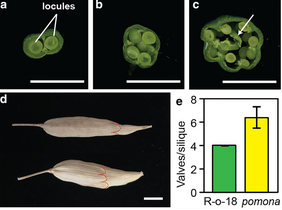 The CLAVATA1 receptor-like kinase and its ligand CLAVATA3 (CLV3) are associated with the CLAVATA-WUSCHEL pathway, which partly controls locule number (the seed-bearing structure of fruits). An increase in locule number is believed to increase the number of seeds and subsequently increase fruit size. Chow et al. investigated the effect of mutation of CLV1 on locule number in Brassica rapa. When a tetralocular B. rapa variety (R-o-18) was mutagenized, a mutant with additional locules was formed, which was named pomona. The pomona phenotype was discovered to be independent of CLV3 and due to a missense mutation in a CLV1. Therefore, pomona was renamed brclv1-1. This study finds that expression of brclv1-1 does not increase seed yield in B. rapa, which may be due to genetic load as a result of other EMS mutations, an additional internal gynoecium occupying the space meant for seed development, or misregulation of other genes. (Summary by Idowu Arinola Obisesan @IdowuAobisesan) Plant Direct 10.1002/pld3.476
The CLAVATA1 receptor-like kinase and its ligand CLAVATA3 (CLV3) are associated with the CLAVATA-WUSCHEL pathway, which partly controls locule number (the seed-bearing structure of fruits). An increase in locule number is believed to increase the number of seeds and subsequently increase fruit size. Chow et al. investigated the effect of mutation of CLV1 on locule number in Brassica rapa. When a tetralocular B. rapa variety (R-o-18) was mutagenized, a mutant with additional locules was formed, which was named pomona. The pomona phenotype was discovered to be independent of CLV3 and due to a missense mutation in a CLV1. Therefore, pomona was renamed brclv1-1. This study finds that expression of brclv1-1 does not increase seed yield in B. rapa, which may be due to genetic load as a result of other EMS mutations, an additional internal gynoecium occupying the space meant for seed development, or misregulation of other genes. (Summary by Idowu Arinola Obisesan @IdowuAobisesan) Plant Direct 10.1002/pld3.476
Target of rapamycin signaling couples energy to oxygen sensing to modulate hypoxic gene expression in Arabidopsis
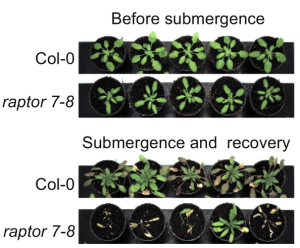 Floods limit plant oxygen availability, impacting their growth and productivity. In hypoxia, the ERF-VII group of transcription factors are stabilized and activate Hypoxia-Responsive Genes (HRG) that prepare the plant to face the stress. In this situation, plant metabolism switches from oxidative phosphorylation in mitochondria to fermentation, decreasing the production of ATP. Four hours after the onset of hypoxia, the expression of HRGs peaks, after which it is dampened to lower the rate of carbohydrate consumption in order to ensure long-lasting survival or possible recovery. This suggests that the oxygen sensing pathway is also regulated by sugar or energy availability. In this work, Kunkowska et al., show that Target Of Rapamycin (TOR) controls the ERF-VII oxygen sensing pathway. When energy availability is optimal, TOR activates RAP2.12 (an important ERF-VII) through the phosphorylation of two serine residues at the C-terminal part of RAP2.12. When there is a lower production of ATP due to hypoxia, TOR activity is reduced and HRGs induction is attenuated. This reveals crosstalk between energy and oxygen sensing in plants through a mechanism (mediated by TOR) that is also present in animal cells. (Summary by Eva Maria Gomez Alvarez, @eva_ga96) PNAS. 10.1073/pnas.2212474120
Floods limit plant oxygen availability, impacting their growth and productivity. In hypoxia, the ERF-VII group of transcription factors are stabilized and activate Hypoxia-Responsive Genes (HRG) that prepare the plant to face the stress. In this situation, plant metabolism switches from oxidative phosphorylation in mitochondria to fermentation, decreasing the production of ATP. Four hours after the onset of hypoxia, the expression of HRGs peaks, after which it is dampened to lower the rate of carbohydrate consumption in order to ensure long-lasting survival or possible recovery. This suggests that the oxygen sensing pathway is also regulated by sugar or energy availability. In this work, Kunkowska et al., show that Target Of Rapamycin (TOR) controls the ERF-VII oxygen sensing pathway. When energy availability is optimal, TOR activates RAP2.12 (an important ERF-VII) through the phosphorylation of two serine residues at the C-terminal part of RAP2.12. When there is a lower production of ATP due to hypoxia, TOR activity is reduced and HRGs induction is attenuated. This reveals crosstalk between energy and oxygen sensing in plants through a mechanism (mediated by TOR) that is also present in animal cells. (Summary by Eva Maria Gomez Alvarez, @eva_ga96) PNAS. 10.1073/pnas.2212474120
Overcoming arsenic stress in plants using iron-oxide doped rice biochar
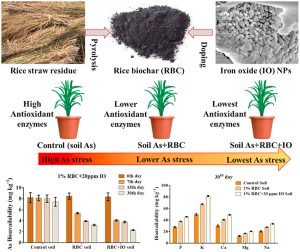 Arsenic (As) contamination in soil influences the physio-chemical properties of plants. Majumdar et al. propose the use of rice biochar (RBC) doped with iron oxide (IO) nanoparticles, an eco-friendly composite, to minimize As toxicity in plants. Rice plants grown on As-contaminated soil with the composite showed reduced stress markers, whereas the control plants grown in As-contaminated soil showed increased markers such as malondialdehyde and total protein content. Assessment of internal vascular structures was performed using field emission scanning electron microscopy. Application of RBC+IO enabled the plant to maintain structural confinements and cellular integrity. However, the control plant suffered severe tissue breakage and fragility. Hence, Majumdar et al. claim that application of RBC+IO reduces the bioavailability of As particles in the soil, thus contributing to the maintenance of anatomical integrity of the rice plants. This study suggests an environmentally sustainable method to reduce As stress in plants and enhance agricultural productivity. (Summary by Kumanan N Govaichelvan, @NGKumanan) Chemosphere, 10.1016/j.chemosphere.2022.137117
Arsenic (As) contamination in soil influences the physio-chemical properties of plants. Majumdar et al. propose the use of rice biochar (RBC) doped with iron oxide (IO) nanoparticles, an eco-friendly composite, to minimize As toxicity in plants. Rice plants grown on As-contaminated soil with the composite showed reduced stress markers, whereas the control plants grown in As-contaminated soil showed increased markers such as malondialdehyde and total protein content. Assessment of internal vascular structures was performed using field emission scanning electron microscopy. Application of RBC+IO enabled the plant to maintain structural confinements and cellular integrity. However, the control plant suffered severe tissue breakage and fragility. Hence, Majumdar et al. claim that application of RBC+IO reduces the bioavailability of As particles in the soil, thus contributing to the maintenance of anatomical integrity of the rice plants. This study suggests an environmentally sustainable method to reduce As stress in plants and enhance agricultural productivity. (Summary by Kumanan N Govaichelvan, @NGKumanan) Chemosphere, 10.1016/j.chemosphere.2022.137117
Boosting plant disease resistance through epigenetics
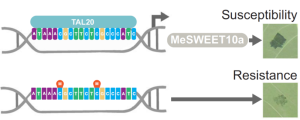 Increasing plant resistance to specific pathogens through genome editing is a very active branch of crop engineering. In a recent paper, Veley et al. propose to edit the epigenome to boost resistance to cassava bacterial blight by increasing the levels of DNA methylation at specific sites, while leaving the DNA sequence unchanged. The authors focus on the susceptibility gene MeSWEET10a, which is targeted by the bacterial effector TAL20. DNA binding by TAL20 is inhibited by methylation. The authors used an artificial zinc-finger (ZF) fused to Arabidopsis DEFECTIVE IN MERISTEM SILENCING 3 (DMS3) to specifically and stably methylate the effector binding element (EBE) targeted by TAL20 within the MaSWEET10a promoter. ZF-DMS3 transgenic plants have increased methylation levels at the MeSWEET10a EBE, but they show no phenotypic defects and their overall genome methylation levels are not affected. Moreover, MeSWEET10a expression, which increases upon infection in WT plants, was strongly reduced in ZF-DMS3 lines. Finally, the authors show that typical bacterial blight symptoms, such as water-soaking, were reduced in ZF-DMS3 plants, indicating that this strategy was successful in improving plant resistance to this disease. As more and more tools to edit the epigenome become available, modifying the DNA sequence may no longer be required to obtain the desired phenotype. (Summary by Laura Turchi @turchi_l) Nature Comms. 10.1038/s41467-022-35675-7.
Increasing plant resistance to specific pathogens through genome editing is a very active branch of crop engineering. In a recent paper, Veley et al. propose to edit the epigenome to boost resistance to cassava bacterial blight by increasing the levels of DNA methylation at specific sites, while leaving the DNA sequence unchanged. The authors focus on the susceptibility gene MeSWEET10a, which is targeted by the bacterial effector TAL20. DNA binding by TAL20 is inhibited by methylation. The authors used an artificial zinc-finger (ZF) fused to Arabidopsis DEFECTIVE IN MERISTEM SILENCING 3 (DMS3) to specifically and stably methylate the effector binding element (EBE) targeted by TAL20 within the MaSWEET10a promoter. ZF-DMS3 transgenic plants have increased methylation levels at the MeSWEET10a EBE, but they show no phenotypic defects and their overall genome methylation levels are not affected. Moreover, MeSWEET10a expression, which increases upon infection in WT plants, was strongly reduced in ZF-DMS3 lines. Finally, the authors show that typical bacterial blight symptoms, such as water-soaking, were reduced in ZF-DMS3 plants, indicating that this strategy was successful in improving plant resistance to this disease. As more and more tools to edit the epigenome become available, modifying the DNA sequence may no longer be required to obtain the desired phenotype. (Summary by Laura Turchi @turchi_l) Nature Comms. 10.1038/s41467-022-35675-7.
Weeding the witchweed by changing strigolactone biosynthesis in maize
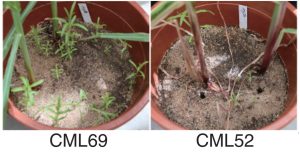 Striga, commonly known as witchweed, compromises the yield of maize (Zea mays) especially in Africa. The seeds of Striga species remain dormant in the soil and are stimulated to germinate by a class of hormones called strigolactones (SL) exuded by the maize roots. Strigolactones are plant hormones with developmental roles and that serve as host signals for beneficial fungi. Plants exude a mix of SLs, and the composition of the exudate differs across species and within species as well. Here, Li et al. investigated natural variation in the mixture of SLs, identified three additional SLs, and uncovered the entire biosynthetic route for SLs in maize. Different SL blends in different genotypes affect Striga germination and infection. The authors discovered that there are two parallel pathways that operate for SL biosynthesis and produce the major SL, zealactone. Changes in flux through these routes can alter the maize SL profile by changing the ratio of zealactol and zealoactone plus zealactonic acid. Maize genotypes that released more zealactol and zealactonic acid than zealactone promote less Striga germination and infection, thereby imparting resistance against it. This research offers promise for breeding Striga resistant maize by adjusting the combination of SL mix. (Summary by Arpita Yadav @arpita_yadav_ ). Science 10.1126/science.abq4775
Striga, commonly known as witchweed, compromises the yield of maize (Zea mays) especially in Africa. The seeds of Striga species remain dormant in the soil and are stimulated to germinate by a class of hormones called strigolactones (SL) exuded by the maize roots. Strigolactones are plant hormones with developmental roles and that serve as host signals for beneficial fungi. Plants exude a mix of SLs, and the composition of the exudate differs across species and within species as well. Here, Li et al. investigated natural variation in the mixture of SLs, identified three additional SLs, and uncovered the entire biosynthetic route for SLs in maize. Different SL blends in different genotypes affect Striga germination and infection. The authors discovered that there are two parallel pathways that operate for SL biosynthesis and produce the major SL, zealactone. Changes in flux through these routes can alter the maize SL profile by changing the ratio of zealactol and zealoactone plus zealactonic acid. Maize genotypes that released more zealactol and zealactonic acid than zealactone promote less Striga germination and infection, thereby imparting resistance against it. This research offers promise for breeding Striga resistant maize by adjusting the combination of SL mix. (Summary by Arpita Yadav @arpita_yadav_ ). Science 10.1126/science.abq4775



